Презентація на тему «The Biography of Mark Twain»

Presentationon "The Biography of Mark Twain"11-student class andVinnikova Anastasia

Mark Twain
Samuel Langhorne Clemens (November 30, 1835 – April 21, 1910), better known by his pen name Mark Twain, was an American author and humorist. He is most noted for his novels, The Adventures of Tom Sawyer (1876), and its sequel, Adventures of Huckleberry Finn (1885), the latter often called "the Great American Novel."
Twain grew up in Hannibal, Missouri, which would later provide the setting for Huckleberry Finnand Tom Sawyer. He apprenticed with a printer. He also worked as a typesetter and contributed articles to his older brother Orion's newspaper. After toiling as a printer in various cities, he became a master riverboat pilot on the Mississippi River, before heading west to join Orion. He was a failure at gold mining, so he next turned to journalism. While a reporter, he wrote a humorous story, "The Celebrated Jumping Frog of Calaveras County", which became very popular and brought nationwide attention. His travelogues were also well-received. Twain had found his calling.

Mark Twain
Samuel Langhorne Clemens (November 30, 1835 – April 21, 1910), better known by his pen name Mark Twain, was an American author and humorist. He is most noted for his novels, The Adventures of Tom Sawyer (1876), and its sequel, Adventures of Huckleberry Finn (1885), the latter often called "the Great American Novel."
Twain grew up in Hannibal, Missouri, which would later provide the setting for Huckleberry Finnand Tom Sawyer. He apprenticed with a printer. He also worked as a typesetter and contributed articles to his older brother Orion's newspaper. After toiling as a printer in various cities, he became a master riverboat pilot on the Mississippi River, before heading west to join Orion. He was a failure at gold mining, so he next turned to journalism. While a reporter, he wrote a humorous story, "The Celebrated Jumping Frog of Calaveras County", which became very popular and brought nationwide attention. His travelogues were also well-received. Twain had found his calling.
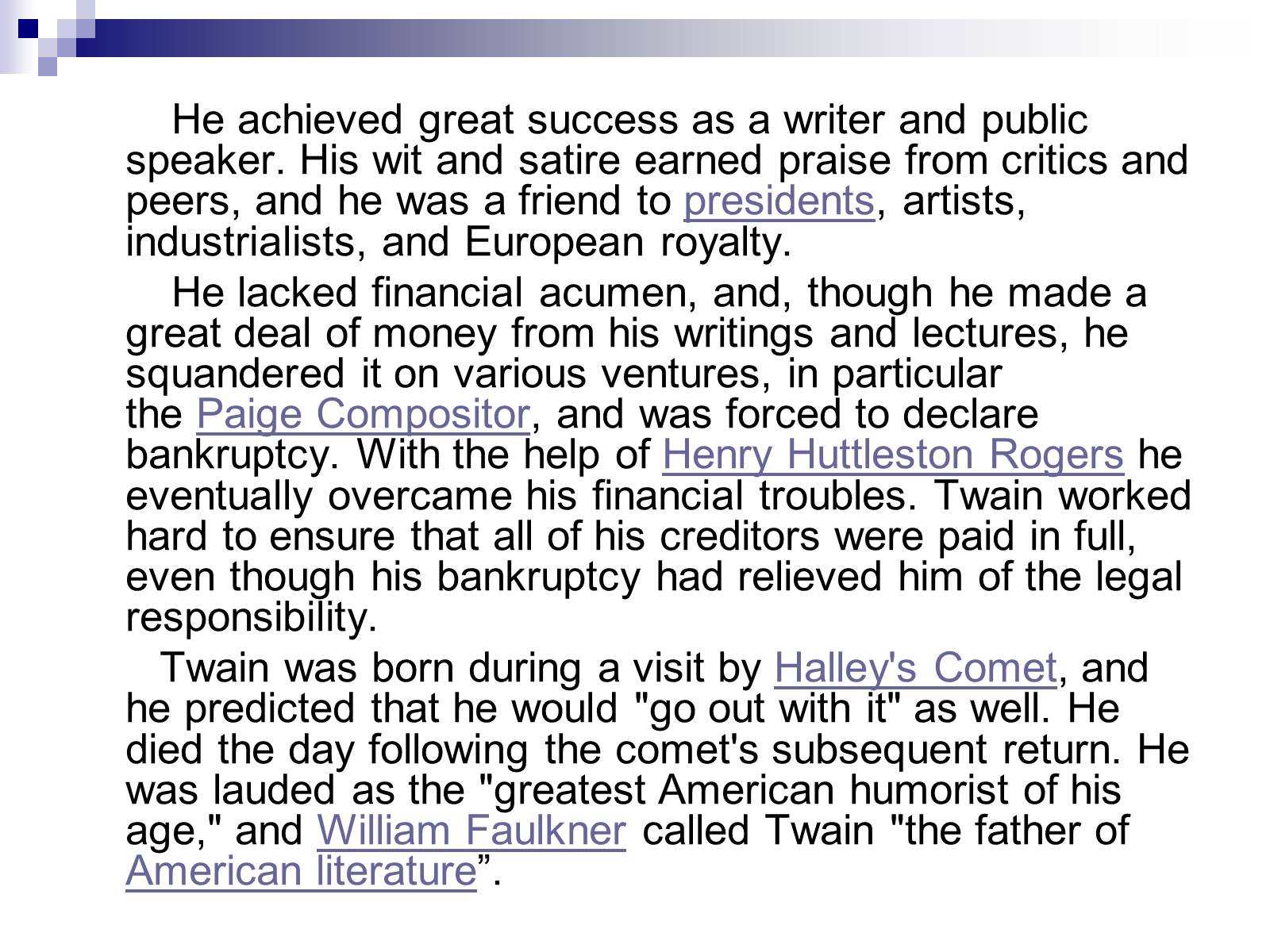
He achieved great success as a writer and public speaker. His wit and satire earned praise from critics and peers, and he was a friend to presidents, artists, industrialists, and European royalty.
He lacked financial acumen, and, though he made a great deal of money from his writings and lectures, he squandered it on various ventures, in particular the Paige Compositor, and was forced to declare bankruptcy. With the help of Henry Huttleston Rogers he eventually overcame his financial troubles. Twain worked hard to ensure that all of his creditors were paid in full, even though his bankruptcy had relieved him of the legal responsibility.
Twain was born during a visit by Halley's Comet, and he predicted that he would "go out with it" as well. He died the day following the comet's subsequent return. He was lauded as the "greatest American humorist of his age," and William Faulkner called Twain "the father of American literature”.
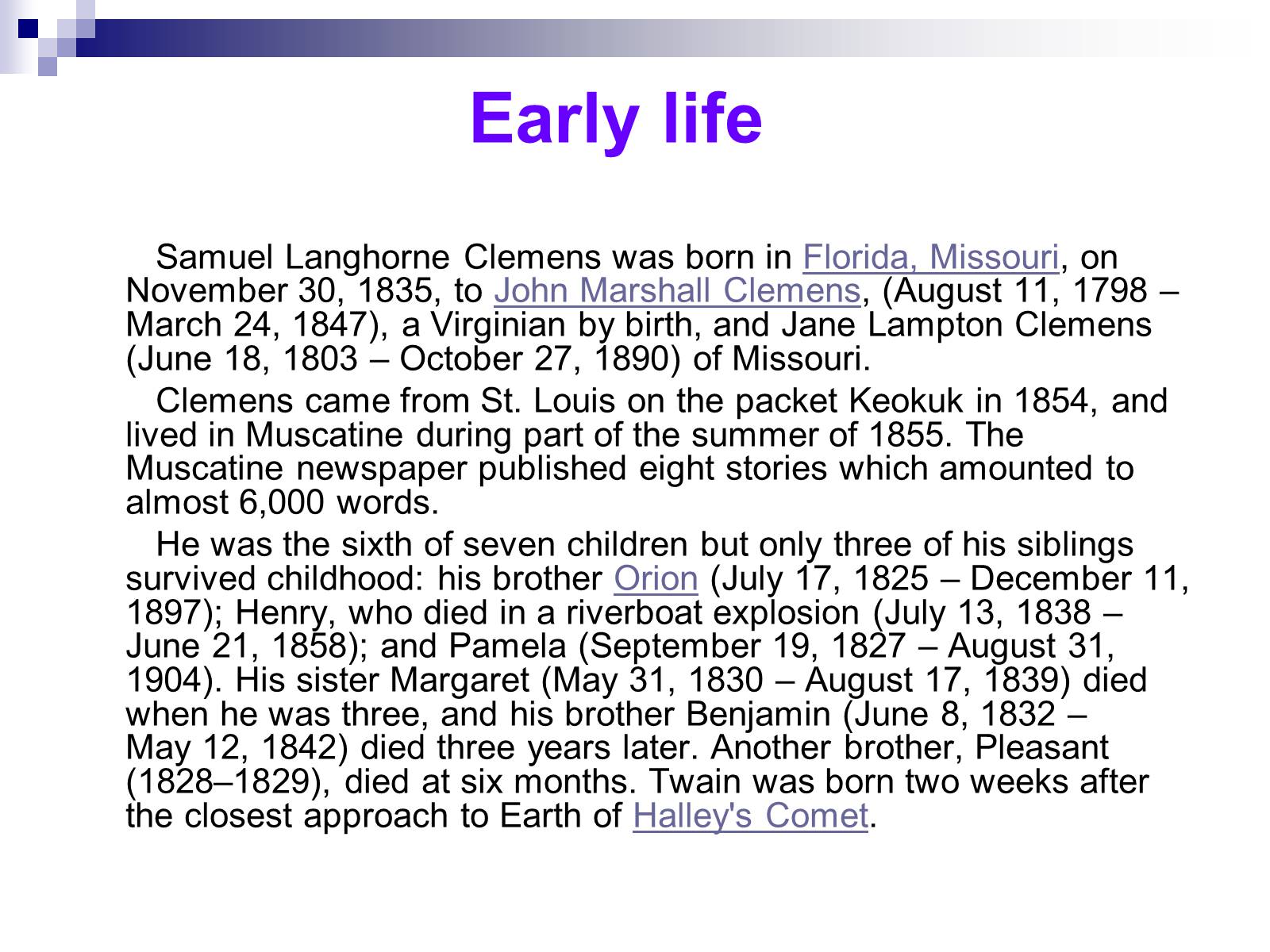
Early life
Samuel Langhorne Clemens was born in Florida, Missouri, on November 30, 1835, to John Marshall Clemens, (August 11, 1798 – March 24, 1847), a Virginian by birth, and Jane Lampton Clemens (June 18, 1803 – October 27, 1890) of Missouri.
Clemens came from St. Louis on the packet Keokuk in 1854, and lived in Muscatine during part of the summer of 1855. The Muscatine newspaper published eight stories which amounted to almost 6,000 words.
He was the sixth of seven children but only three of his siblings survived childhood: his brother Orion (July 17, 1825 – December 11, 1897); Henry, who died in a riverboat explosion (July 13, 1838 – June 21, 1858); and Pamela (September 19, 1827 – August 31, 1904). His sister Margaret (May 31, 1830 – August 17, 1839) died when he was three, and his brother Benjamin (June 8, 1832 – May 12, 1842) died three years later. Another brother, Pleasant (1828–1829), died at six months. Twain was born two weeks after the closest approach to Earth of Halley's Comet.

Samuel Clemens, age 15
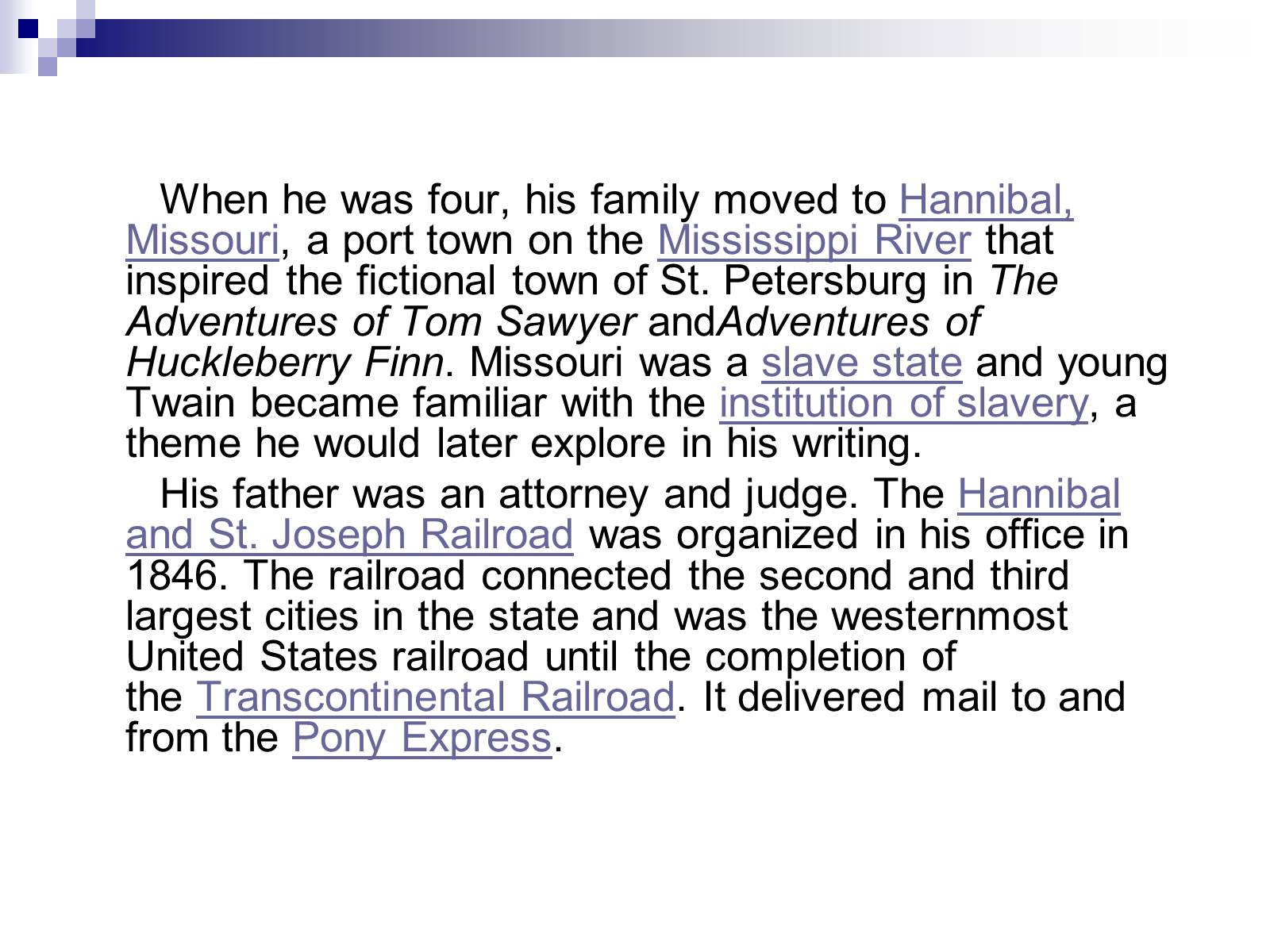
When he was four, his family moved to Hannibal, Missouri, a port town on the Mississippi River that inspired the fictional town of St. Petersburg in The Adventures of Tom Sawyer andAdventures of Huckleberry Finn. Missouri was a slave state and young Twain became familiar with the institution of slavery, a theme he would later explore in his writing.
His father was an attorney and judge. The Hannibal and St. Joseph Railroad was organized in his office in 1846. The railroad connected the second and third largest cities in the state and was the westernmost United States railroad until the completion of the Transcontinental Railroad. It delivered mail to and from the Pony Express.
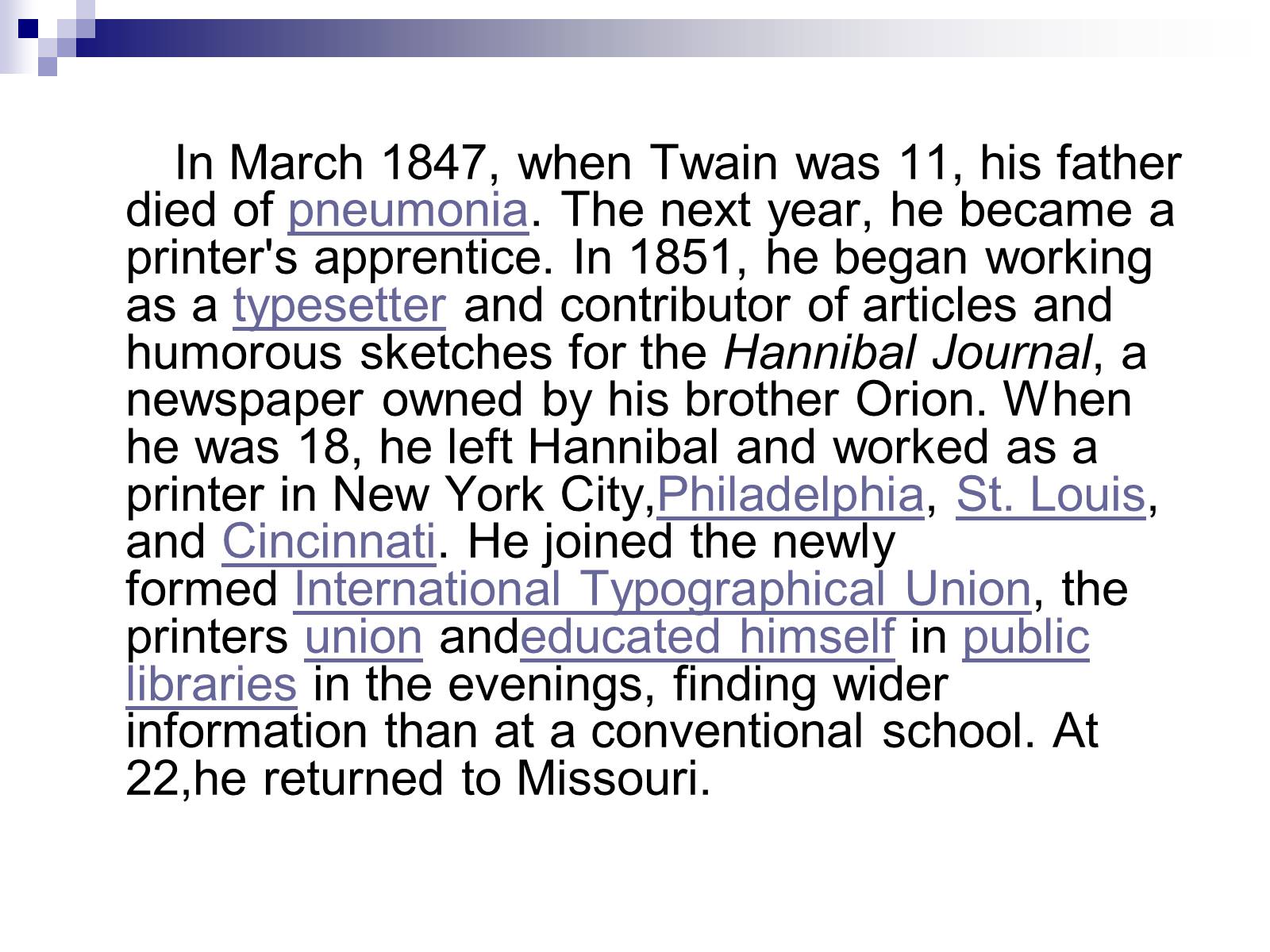
In March 1847, when Twain was 11, his father died of pneumonia. The next year, he became a printer's apprentice. In 1851, he began working as a typesetter and contributor of articles and humorous sketches for the Hannibal Journal, a newspaper owned by his brother Orion. When he was 18, he left Hannibal and worked as a printer in New York City,Philadelphia, St. Louis, and Cincinnati. He joined the newly formed International Typographical Union, the printers union andeducated himself in public libraries in the evenings, finding wider information than at a conventional school. At 22,he returned to Missouri.

On a voyage to New Orleans down the Mississippi, steamboat pilot Horace E. Bixby inspired Twain to become a pilot himself. As Twain observed in Life on the Mississippi, the pilot surpassed a steamboat's captain in prestige and authority; it was a rewarding occupation with wages set at $250 per month. A steamboat pilot needed to know the ever-changing river to be able to stop at the hundreds of ports and wood-lots. Twain studied 2,000 miles (3,200 km) of the Mississippi for more than two years before he received his steamboat pilot license in 1859. This occupation gave him his pen name, Mark Twain, from "mark twain," the cry for a measured river depth of two fathoms.
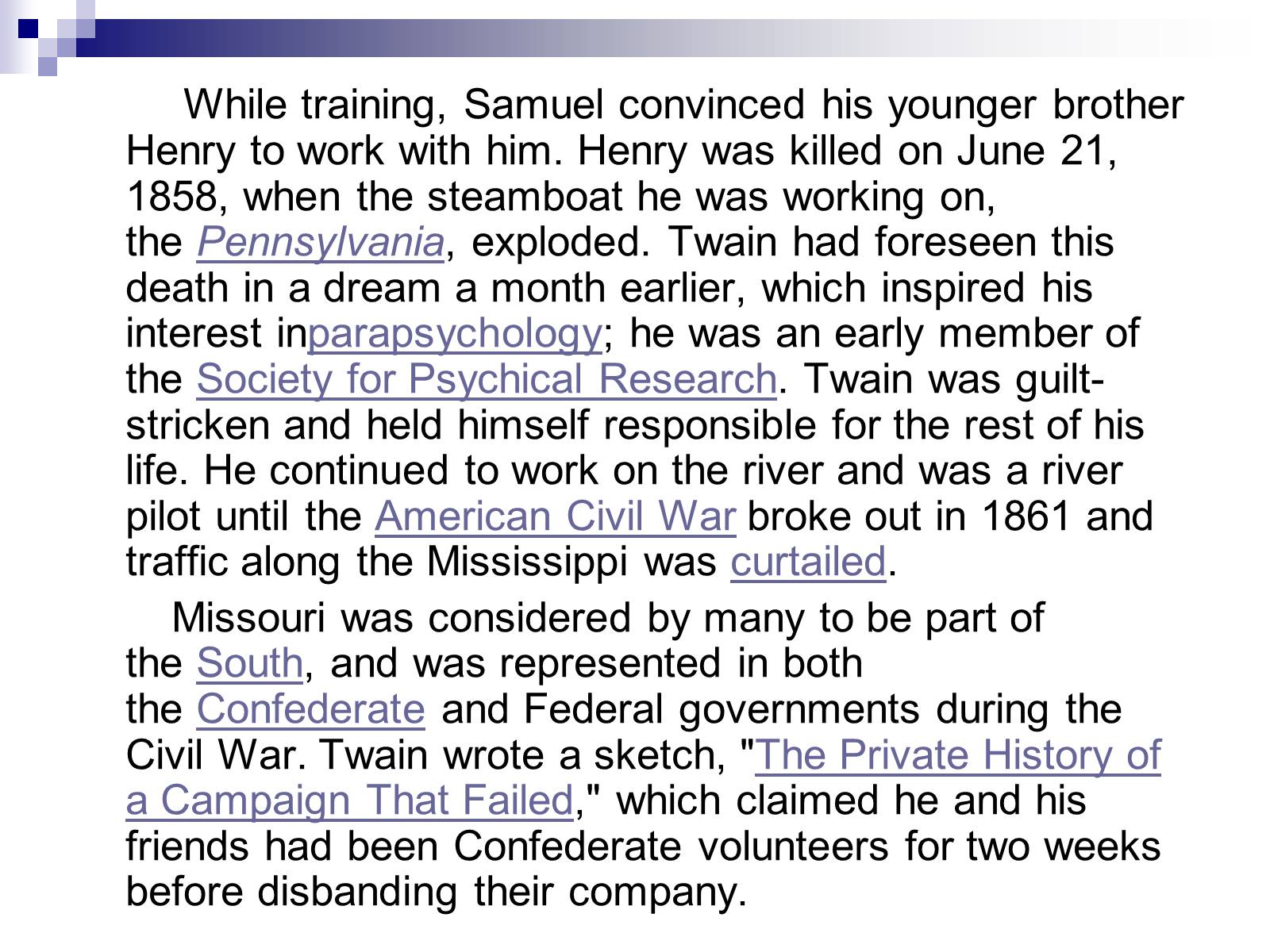
While training, Samuel convinced his younger brother Henry to work with him. Henry was killed on June 21, 1858, when the steamboat he was working on, the Pennsylvania, exploded. Twain had foreseen this death in a dream a month earlier, which inspired his interest inparapsychology; he was an early member of the Society for Psychical Research. Twain was guilt-stricken and held himself responsible for the rest of his life. He continued to work on the river and was a river pilot until the American Civil War broke out in 1861 and traffic along the Mississippi was curtailed.
Missouri was considered by many to be part of the South, and was represented in both the Confederate and Federal governments during the Civil War. Twain wrote a sketch, "The Private History of a Campaign That Failed," which claimed he and his friends had been Confederate volunteers for two weeks before disbanding their company.
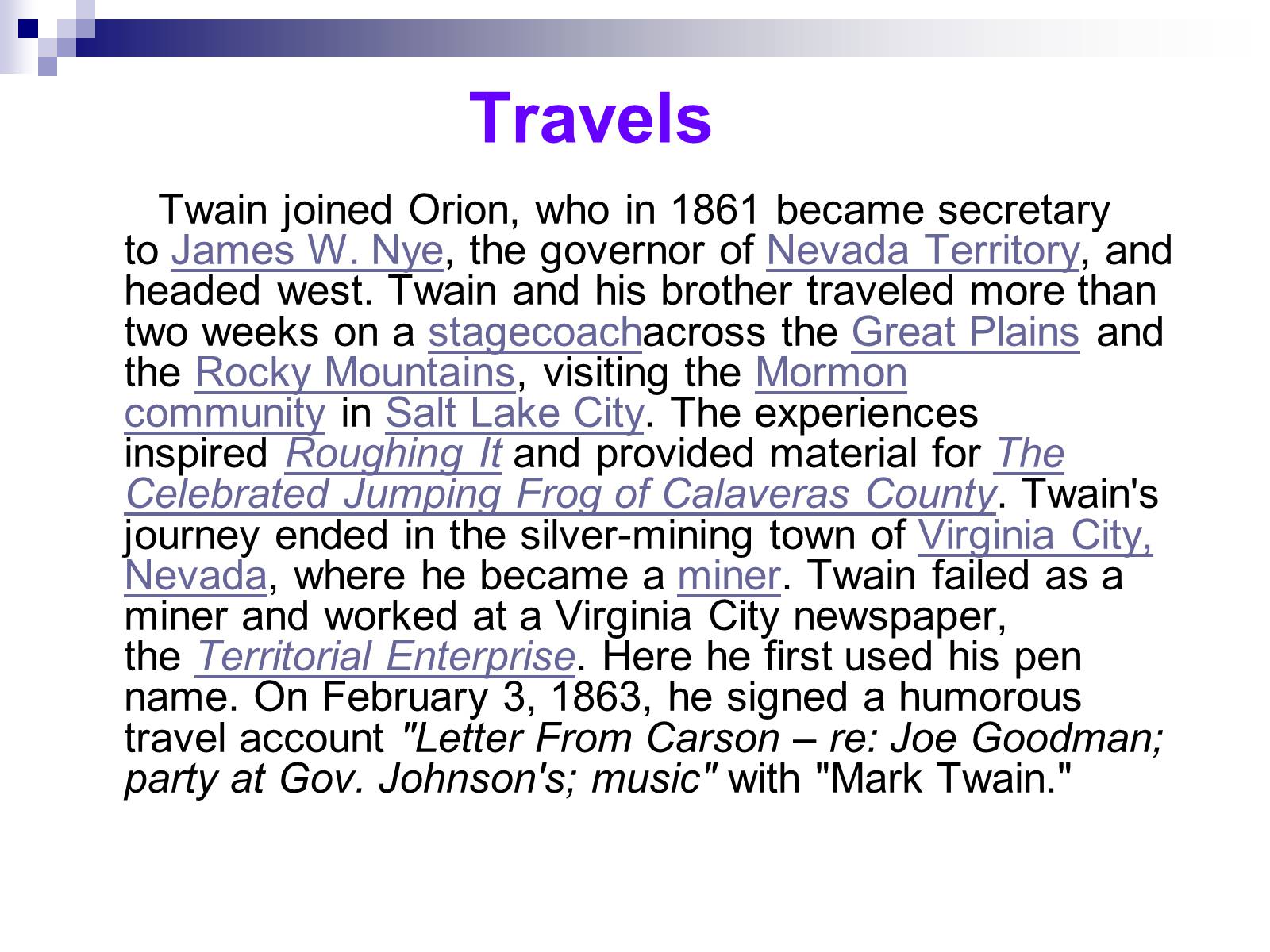
Travels
Twain joined Orion, who in 1861 became secretary to James W. Nye, the governor of Nevada Territory, and headed west. Twain and his brother traveled more than two weeks on a stagecoachacross the Great Plains and the Rocky Mountains, visiting the Mormon community in Salt Lake City. The experiences inspired Roughing It and provided material for The Celebrated Jumping Frog of Calaveras County. Twain's journey ended in the silver-mining town of Virginia City, Nevada, where he became a miner. Twain failed as a miner and worked at a Virginia City newspaper, the Territorial Enterprise. Here he first used his pen name. On February 3, 1863, he signed a humorous travel account "Letter From Carson – re: Joe Goodman; party at Gov. Johnson's; music" with "Mark Twain."

Library of Twain House, with hand-stenciled paneling, fireplaces from India, embossed wallpapers, and hand- carved mantel purchased in Scotland
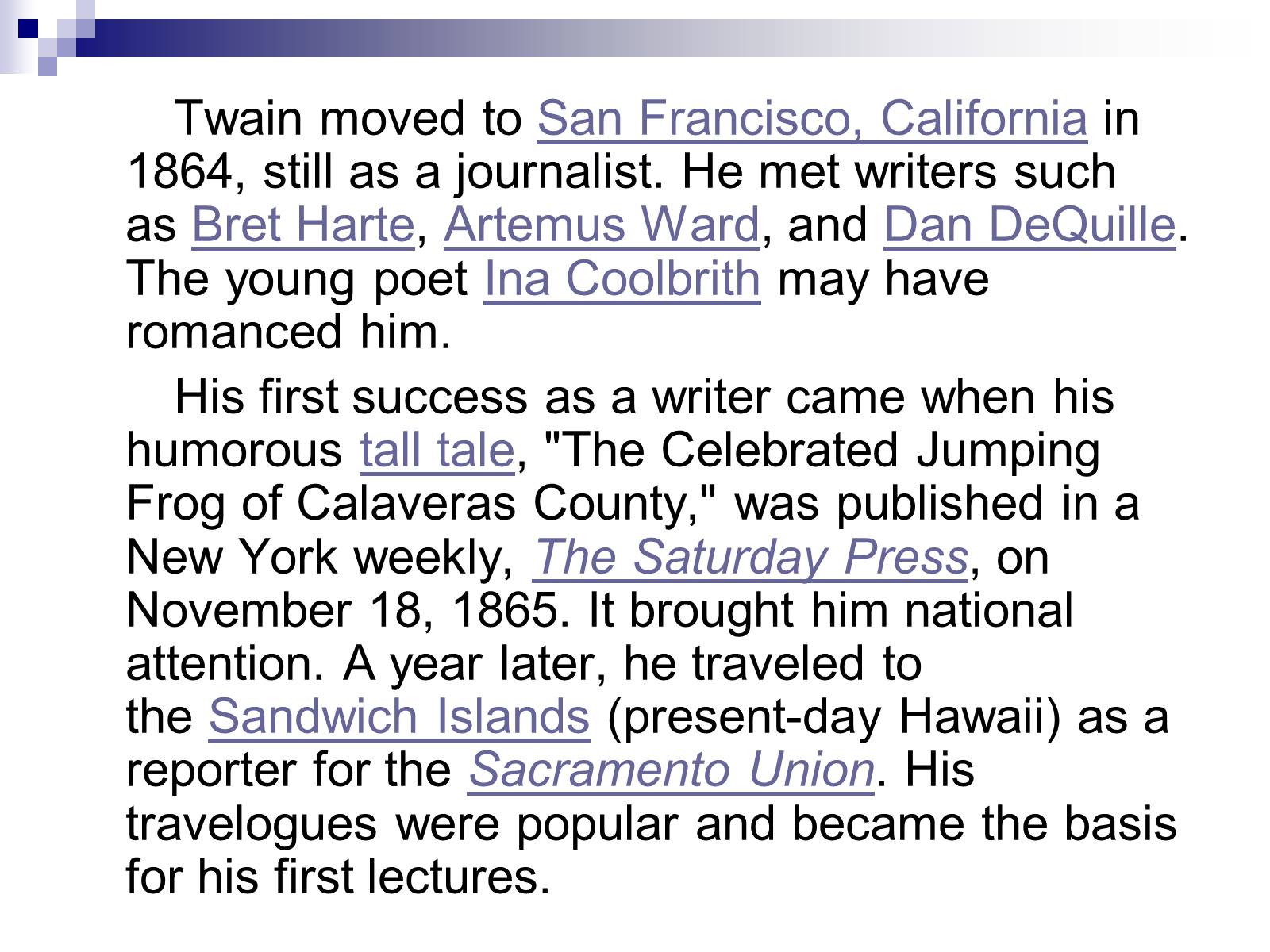
Twain moved to San Francisco, California in 1864, still as a journalist. He met writers such as Bret Harte, Artemus Ward, and Dan DeQuille. The young poet Ina Coolbrith may have romanced him.
His first success as a writer came when his humorous tall tale, "The Celebrated Jumping Frog of Calaveras County," was published in a New York weekly, The Saturday Press, on November 18, 1865. It brought him national attention. A year later, he traveled to the Sandwich Islands (present-day Hawaii) as a reporter for the Sacramento Union. His travelogues were popular and became the basis for his first lectures.
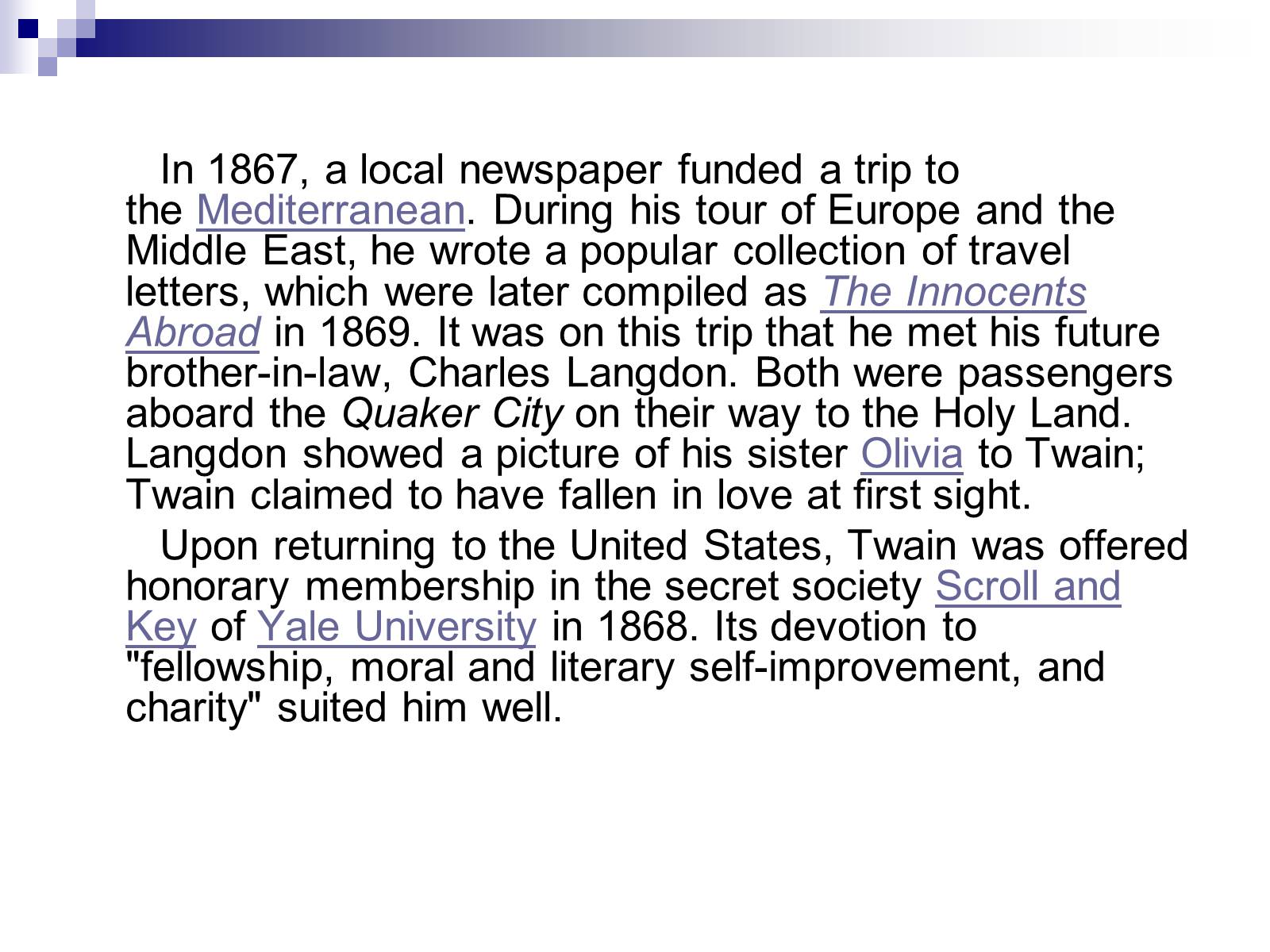
In 1867, a local newspaper funded a trip to the Mediterranean. During his tour of Europe and the Middle East, he wrote a popular collection of travel letters, which were later compiled as The Innocents Abroad in 1869. It was on this trip that he met his future brother-in-law, Charles Langdon. Both were passengers aboard the Quaker City on their way to the Holy Land. Langdon showed a picture of his sister Olivia to Twain; Twain claimed to have fallen in love at first sight.
Upon returning to the United States, Twain was offered honorary membership in the secret society Scroll and Key of Yale University in 1868. Its devotion to "fellowship, moral and literary self-improvement, and charity" suited him well.
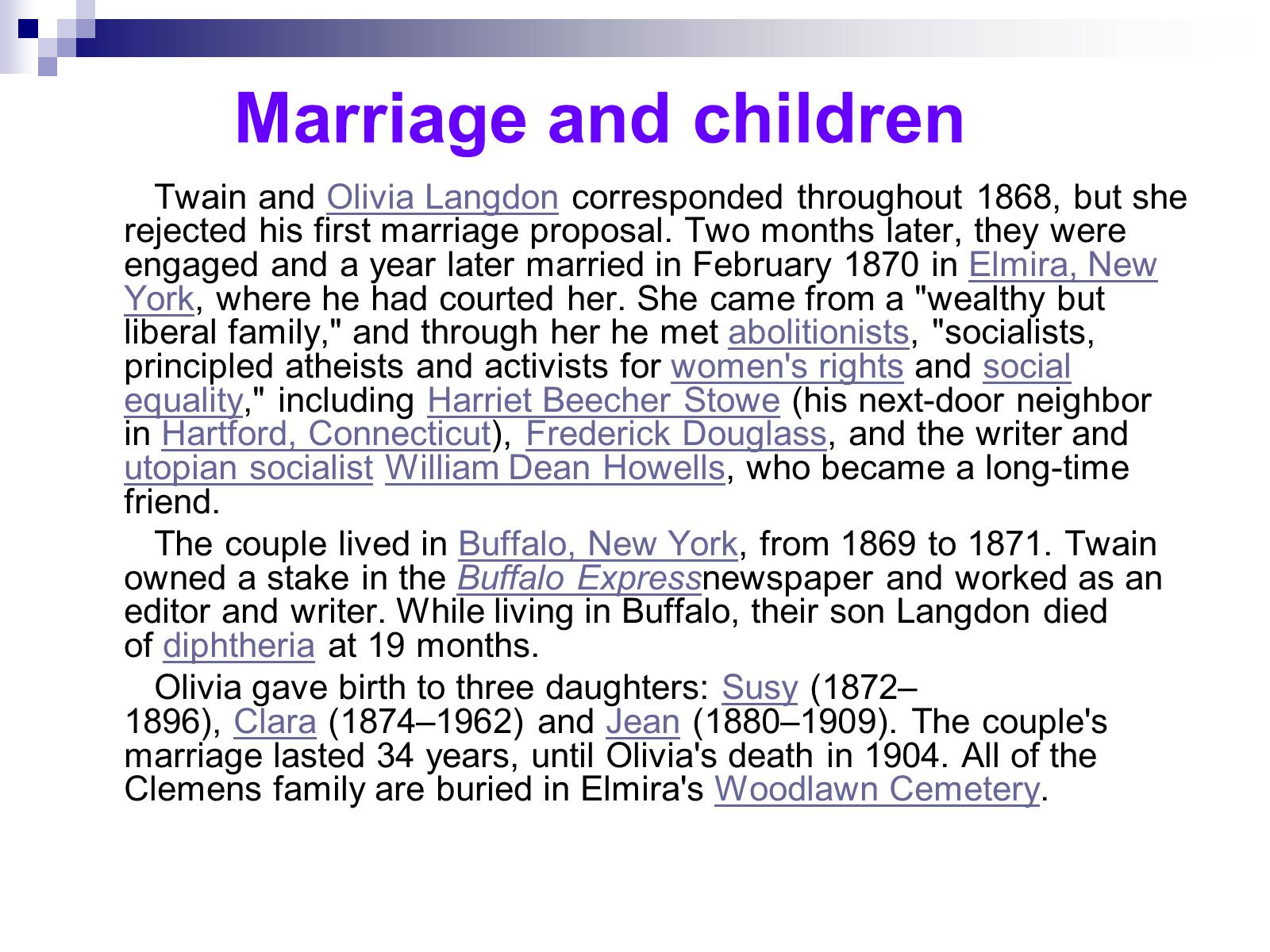
Marriage and children
Twain and Olivia Langdon corresponded throughout 1868, but she rejected his first marriage proposal. Two months later, they were engaged and a year later married in February 1870 in Elmira, New York, where he had courted her. She came from a "wealthy but liberal family," and through her he met abolitionists, "socialists, principled atheists and activists for women's rights and social equality," including Harriet Beecher Stowe (his next-door neighbor in Hartford, Connecticut), Frederick Douglass, and the writer and utopian socialist William Dean Howells, who became a long-time friend.
The couple lived in Buffalo, New York, from 1869 to 1871. Twain owned a stake in the Buffalo Expressnewspaper and worked as an editor and writer. While living in Buffalo, their son Langdon died of diphtheria at 19 months.
Olivia gave birth to three daughters: Susy (1872–1896), Clara (1874–1962) and Jean (1880–1909). The couple's marriage lasted 34 years, until Olivia's death in 1904. All of the Clemens family are buried in Elmira's Woodlawn Cemetery.
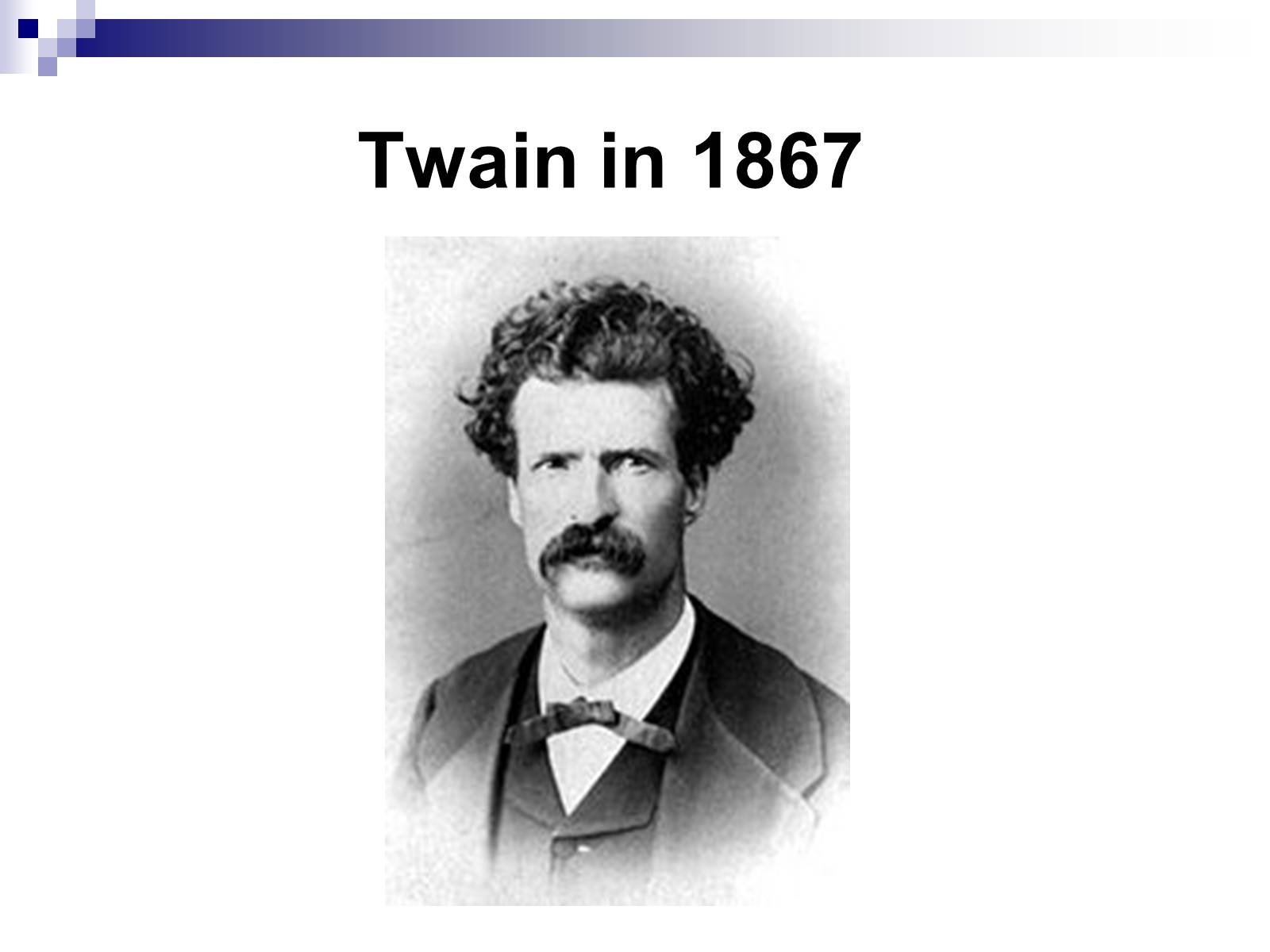
Twain in 1867
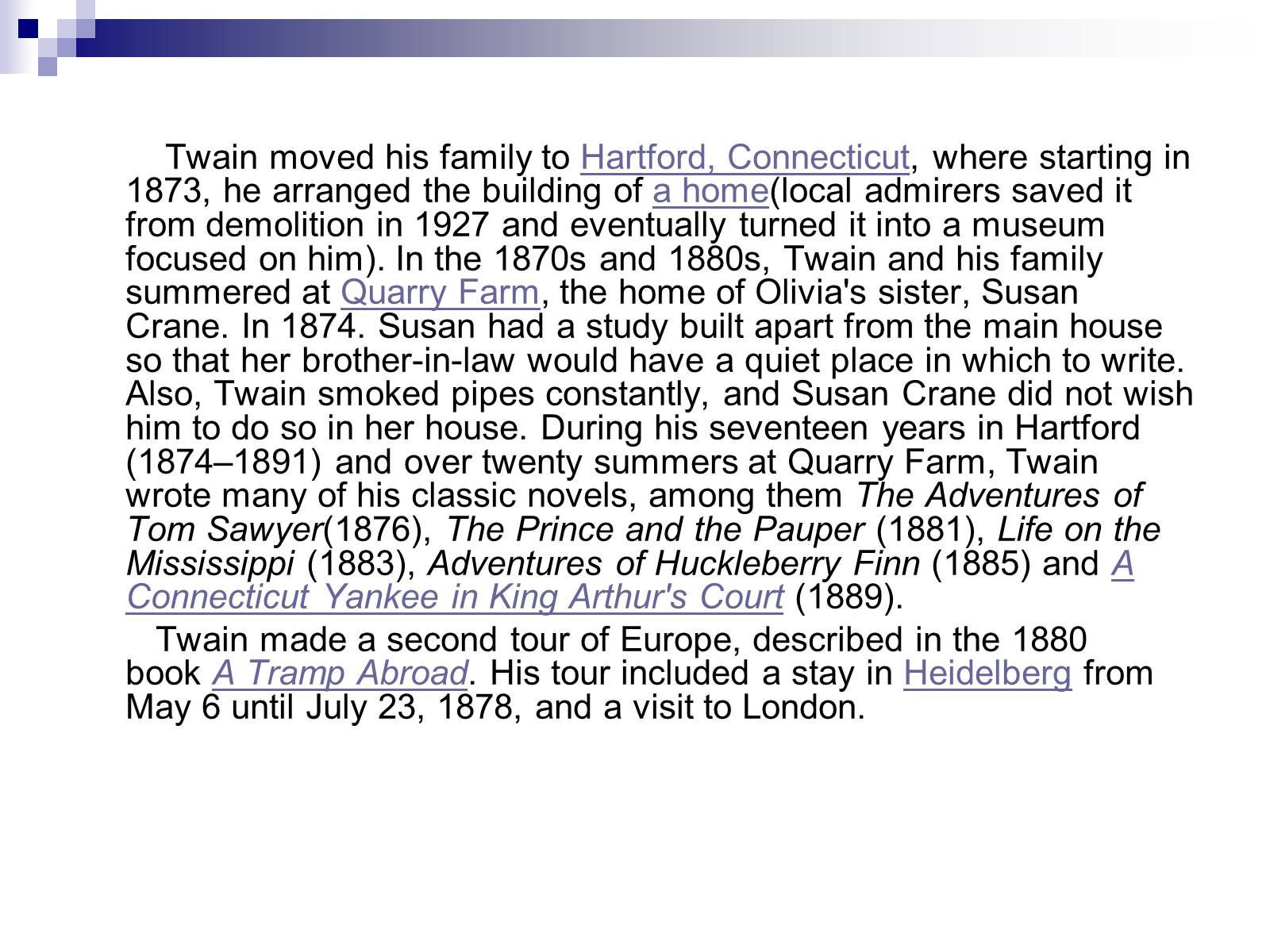
Twain moved his family to Hartford, Connecticut, where starting in 1873, he arranged the building of a home(local admirers saved it from demolition in 1927 and eventually turned it into a museum focused on him). In the 1870s and 1880s, Twain and his family summered at Quarry Farm, the home of Olivia's sister, Susan Crane. In 1874. Susan had a study built apart from the main house so that her brother-in-law would have a quiet place in which to write. Also, Twain smoked pipes constantly, and Susan Crane did not wish him to do so in her house. During his seventeen years in Hartford (1874–1891) and over twenty summers at Quarry Farm, Twain wrote many of his classic novels, among them The Adventures of Tom Sawyer(1876), The Prince and the Pauper (1881), Life on the Mississippi (1883), Adventures of Huckleberry Finn (1885) and A Connecticut Yankee in King Arthur's Court (1889).
Twain made a second tour of Europe, described in the 1880 book A Tramp Abroad. His tour included a stay in Heidelberg from May 6 until July 23, 1878, and a visit to London.
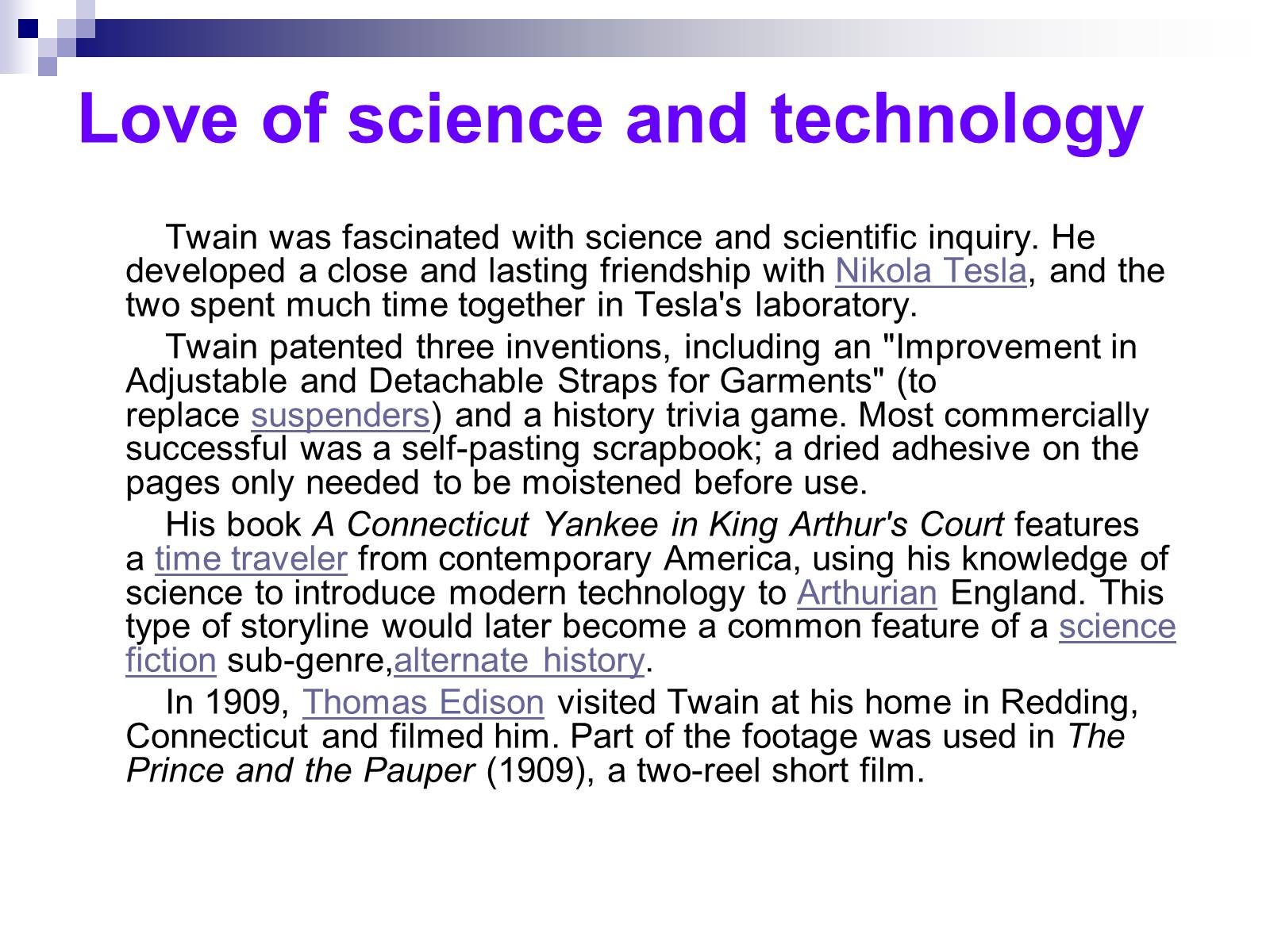
Love of science and technology
Twain was fascinated with science and scientific inquiry. He developed a close and lasting friendship with Nikola Tesla, and the two spent much time together in Tesla's laboratory.
Twain patented three inventions, including an "Improvement in Adjustable and Detachable Straps for Garments" (to replace suspenders) and a history trivia game. Most commercially successful was a self-pasting scrapbook; a dried adhesive on the pages only needed to be moistened before use.
His book A Connecticut Yankee in King Arthur's Court features a time traveler from contemporary America, using his knowledge of science to introduce modern technology to Arthurian England. This type of storyline would later become a common feature of a science fiction sub-genre,alternate history.
In 1909, Thomas Edison visited Twain at his home in Redding, Connecticut and filmed him. Part of the footage was used in The Prince and the Pauper (1909), a two-reel short film.

Twain in the lab of Nikola Tesla, early 1894

Speaking engagements
Twain was in demand as a featured speaker, performing solo humorous talks similar to what would become stand-up comedy. He gave paid talks to many men's clubs, including the Authors' Club, Beefsteak Club, Vagabonds, White Friars, and Monday Evening Club of Hartford. He was made an honorary member of the Bohemian Club in San Francisco. In the late 1890s, he spoke to the Savage Club in London and was elected honorary member. When told that only three men had been so honored, including the Prince of Wales, he replied "Well, it must make the Prince feel mighty fine." In 1897, Twain spoke to the Concordia Press Club in Vienna as a special guest, following diplomatCharlemagne Tower, Jr.. In German, to the great amusement of the assemblage, Twain delivered the speech "Die Schrecken der deutschen Sprache" ("The Horrors of the German Language").
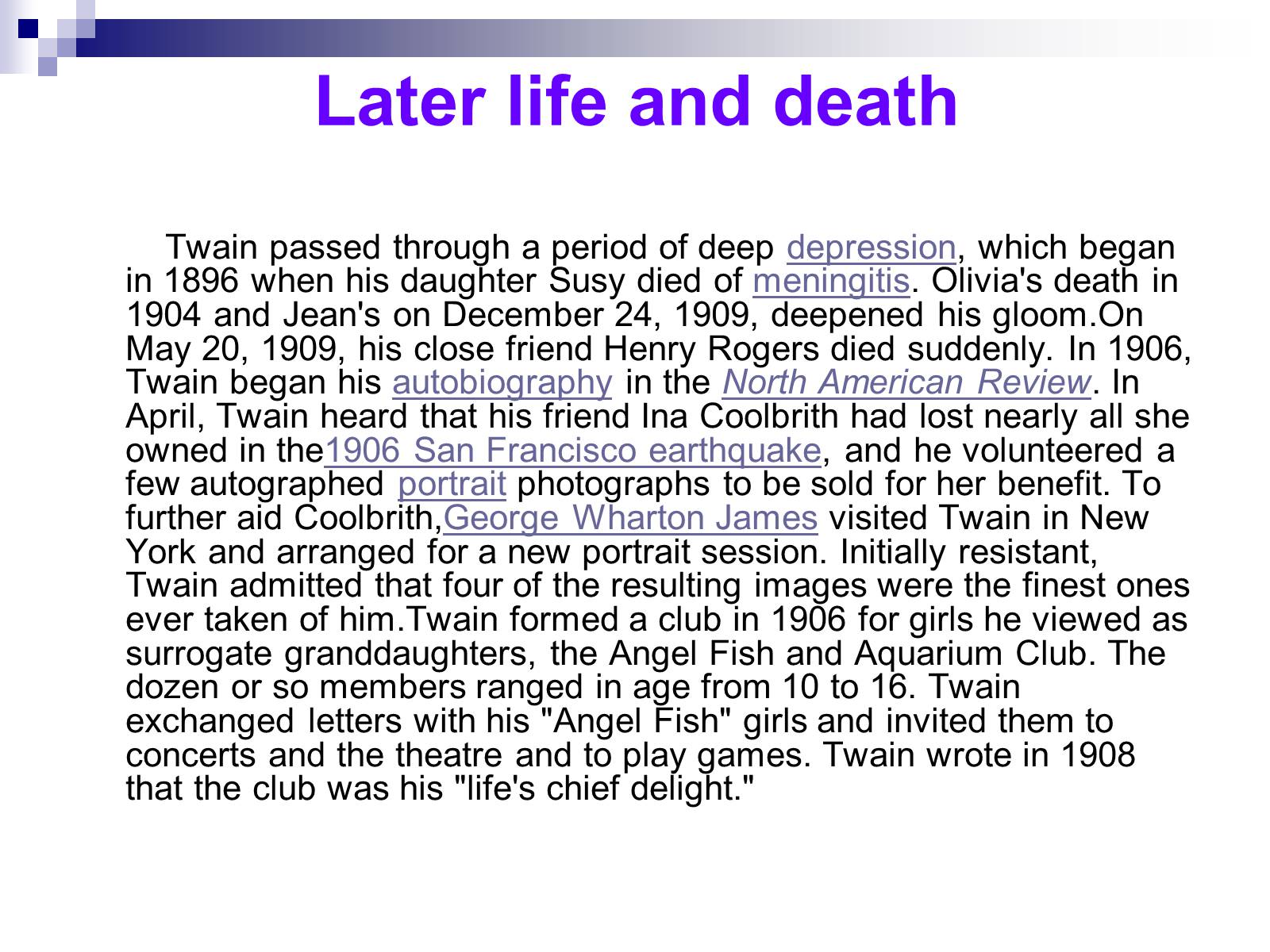
Later life and death
Twain passed through a period of deep depression, which began in 1896 when his daughter Susy died of meningitis. Olivia's death in 1904 and Jean's on December 24, 1909, deepened his gloom.On May 20, 1909, his close friend Henry Rogers died suddenly. In 1906, Twain began his autobiography in the North American Review. In April, Twain heard that his friend Ina Coolbrith had lost nearly all she owned in the1906 San Francisco earthquake, and he volunteered a few autographed portrait photographs to be sold for her benefit. To further aid Coolbrith,George Wharton James visited Twain in New York and arranged for a new portrait session. Initially resistant, Twain admitted that four of the resulting images were the finest ones ever taken of him.Twain formed a club in 1906 for girls he viewed as surrogate granddaughters, the Angel Fish and Aquarium Club. The dozen or so members ranged in age from 10 to 16. Twain exchanged letters with his "Angel Fish" girls and invited them to concerts and the theatre and to play games. Twain wrote in 1908 that the club was his "life's chief delight."

Mark Twain headstone in Woodlawn Cemetery.
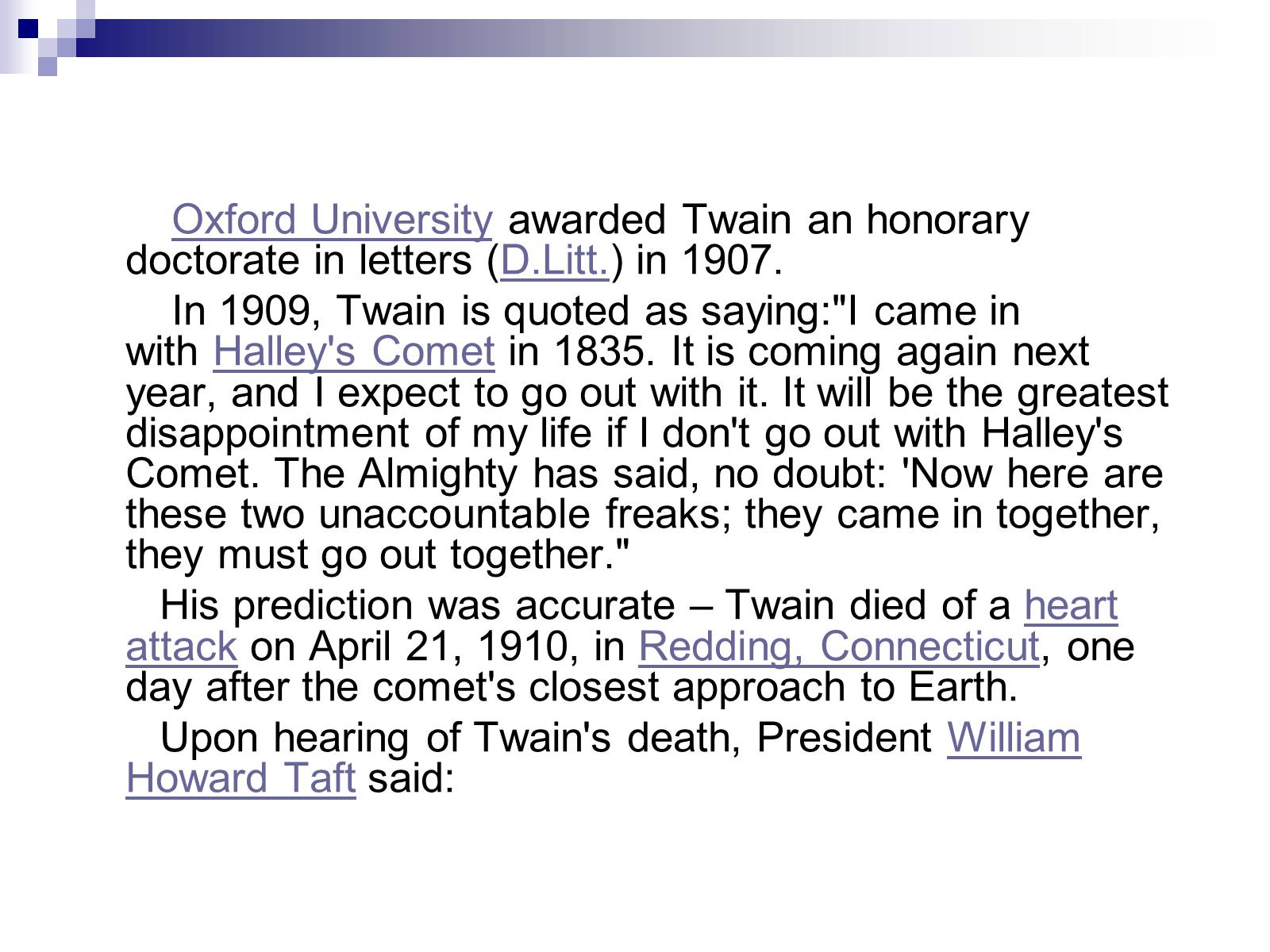
Oxford University awarded Twain an honorary doctorate in letters (D.Litt.) in 1907.
In 1909, Twain is quoted as saying:"I came in with Halley's Comet in 1835. It is coming again next year, and I expect to go out with it. It will be the greatest disappointment of my life if I don't go out with Halley's Comet. The Almighty has said, no doubt: 'Now here are these two unaccountable freaks; they came in together, they must go out together."
His prediction was accurate – Twain died of a heart attack on April 21, 1910, in Redding, Connecticut, one day after the comet's closest approach to Earth.
Upon hearing of Twain's death, President William Howard Taft said:

"Mark Twain gave pleasure – real intellectual enjoyment – to millions, and his works will continue to give such pleasure to millions yet to come... His humor was American, but he was nearly as much appreciated by Englishmen and people of other countries as by his own countrymen. He has made an enduring part of American literature."
Twain's funeral was at the "Old Brick" Presbyterian Church in New York. He is buried in his wife's family plot at Woodlawn Cemetery inElmira, New York. His grave is marked by a 12-foot (i.e., two fathoms, or "mark twain") monument, placed there by his surviving daughter, Clara. There is also a smaller headstone.

Thank you!